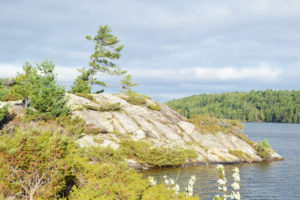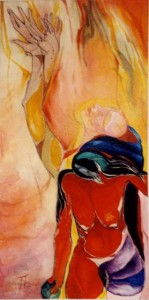Dear Artist,
Earlier this week, a person whose opinion I respect came into my studio and made some remarks about the surface quality of my paintings. While deeply encouraging, the following day I found myself longing to make my work better. Ways of refining an already technical process suddenly became apparent to me and, like a door opening to an unknown room in my house, the new idea expanded in discovery and play.
Belief, like a swig of brandy, gives courage. My moment of fleeting praise may have steadied me for the difficult task of letting go. “Something must die in order for something else to be born,” says the first rule of story writing. “The human heart is so delicate and sensitive,” wrote Maya Angelou, “that it always needs some tangible encouragement to prevent it from faltering in its labour.”
The difference between perfectly adequate and magical is about five percent. I removed a couple of hundred staples and re-stretched a 72 x 60. Only from working again and again within this five percent have I come to a deeper understanding of how my materials and ideas function. On top of this, ceding a good execution in pursuit of something otherworldly yields more fleshed-out creative goals. Here are a few ideas:
Consider, if only for today, that you are in the business of producing the very best example of what you do in the world. Maybe it’s bird anatomy. Or boat anatomy. Maybe it’s as simple and also tricky as a gradation in acrylic. Might you elevate the skill of flawlessly moving up and down the colour wheel to the realm of mastery?
Next, there’s always an opportunity to tweak and polish ideas, to add to their intrigue so that they elevate your work beyond its initial offering. A plein-air mountain rendering can become a humbling meditation on receding glaciers, for example. How do you get there? Resist the temptation to generalize your subject, but rather reveal its universal, human truth by sharing your personal lens. Title, time and location accuracy and signals of the self hold strong against more generic alarms.
Lastly, in painting, the magic we seek is an ineffable cocktail of technical mastery, intention, idea, composition and personal élan that lifts our work beyond perfunctory, picture-making rote. Are you in there? Is your heart? Because you are the magic. “Mastery is the rudder, mystery is the sail,” said singer-songwriter Jack White, “and magic the wind to move you in your chosen direction.”
Sincerely,
Sara
PS: “Quality is never an accident; it is always the result of intelligent effort.” (John Ruskin)
Esoterica: Whatever it is you are doing in art, do it as well as possible, with your heart, knowing that it takes a lifetime to improve. While you’re at it, you’ll notice a moving target in front of you. This is the fun part. “It’s neither contrived, nor surprising and smart, not baffling, not witty, not interesting, not cynical, it can’t be planned and it probably can’t even be described,” wrote Gerhard Richter. “It’s just good.”
“Shall I tell you what I think are the two qualities of a work of art? First, it must be indescribable, and, second, it must be inimitable.” (Pierre-Auguste Renoir)
 The Letters: Vol. 1 and 2, narrated by Dave Genn, are available for download on Amazon, here. Proceeds of sales contribute to the production of The Painter’s Keys.
The Letters: Vol. 1 and 2, narrated by Dave Genn, are available for download on Amazon, here. Proceeds of sales contribute to the production of The Painter’s Keys.
“Correction does much, but encouragement does more.” (Johann Wolfgang von Goethe)
Featured Workshop
Six days in the Near North of Ontario Canada. Killarney and the La Cloche Mountains were a favourite location the Group of Seven visited to paint. Rugged, with granite cliffs thrusting hundreds of feet out of the water. Northern forest, islands, bald rocks and only accessible by boat. We travel to most locations on a sturdy pontoon boat. Whether it’s setting up on a rock face, a low lying island, or sitting at the base of a waterfall, every view is worth capturing. You stay in rustic cabins, each with its own cooking facilities. There is a large room we can paint in if the weather turns against us. Your instructor is Keith Thirgood who has been teaching adults to paint for 12 years. He will show you a step by step approach to painting en plein air, which makes capturing a scene easier than you might have thought possible. He’ll also teach Modern Colour Theory with a limited palette, which makes colour mixing easy.
For more information, visit www.wilsonstreetstudios.com.
Featured Artist
Monique Jarry is a Canadian and a graduate of the Ecole des Beaux-Arts de Montreal.









13 Comments
1000% yes. Thank you.
Thank you for this. Always love reading your insight.
I love your choice of art to illustrate your central point! Aha!
I haven’t seen the Richter photos with oil before. I already knew he was one of our greatest painters– if not THE greatest– but I had no idea that oil on color photograph could be so expressive, while appearing so simply done. Nothing that comes from the eye of an artist is simple. Thank you.
Something magical about being ‘well said’
I’m not sure that experimenting with one’s own style is something that will make their art more magical. I believe that as a fine art painter my goal is to produce the best possible paintings/drawings that is within my spirit and God-given abilities.
Beautiful words, Sara. You reached deep with this letter. Thank you.
Yours and my timing were right when I accessed your thoughtful piece of writing. It speaks to me as I try to bring some resolution to 3 paintings and, as I prepare to visit the members preview of a show in which I have submitted a self portrait oil painting. The call was for self portraits otherwise I would have submitted a floral, or landscape or ventured an oil abstract, a crazy new venture by the way. Thank you for encouraging the magic in myself that I sometimes forget exists within. My eyes and heart will be wide open tonight as I receive the magic of my fellow artists.
Reading Renoir’s comment above I was reminded of seeing a large showing of the Impressionist’s work that was touring the US prior to being parked in a museum in Europe. These are my favorite artists and I had greatly anticipated the opportunity to see these original painting with my own eyes. I am not well traveled and had little opportunity to view any of these originals in person previously other than the occasional museum owned copy of one of them, or one of them on loan.
I was not disappointed with my experience.
Two things are still quite clear in my memory all these years later.
I had never appreciated the popularity of Van Gogh’s work as I had seen only photographs or prints of his work. Nothing I had ever seen prepared me for what I saw. One of his bouquet of flowers paintings literally sparkled and vibrated in the eye. Something I had never seen previously in another work of art. These elements are not captured by a camera. The vibration of the flight of the crows against the wheat field indicates movement within the eye.
“Luncheon of the Boating Party,” which is one of my all-time favorites, delighted me in person. The cheek of the prominent young woman is flushed from the wine and the heat, this I knew from the copies and prints that I had seen. The fact that her face and neck glistened from tiny beads of perspiration as well was totally unknown to me. I am not sure how that effect was painted, or if it is cleverly insinuated and painted in by the mind, but I perceived it in any case. I was totally amazed. Inimitable indeed!
Well said. It is too easy to become comfortable within your style when your work is recognized as very good and your audience enjoys it. It’s hard to break away to push the boundaries, and face failure and discomfort along the way as you strife for what your heart and vision are seeking. Art is a journey. It’s not meant to be easy as you seek your true expression.
Great stuff as usual Sara, but are you sure you have the right “Jack White” there? Is it indeed the Detroit musician or the Texas painter? No big from a readers perspective – wisdom and insight is wisdom and insight – but writers may want the source verified. ;o)
I’m a fan of both!
Keep up the great work!
“Shall I tell you what I think are the two qualities of a work of art? First, it must be indescribable, and, second, it must be inimitable.” (Pierre-Auguste Renoir) I like that quote, especially the use of the word “inimitable.” I think that defines art for me.
Thanks Sara. I enjoyed your post and it is so relevant to what I have been doing lately. I have been reworking nice paintings into kick ass paintings that I am really proud of. I would rather destroy a work that is good in the process of makin it great than live with something that is not the best I can do.